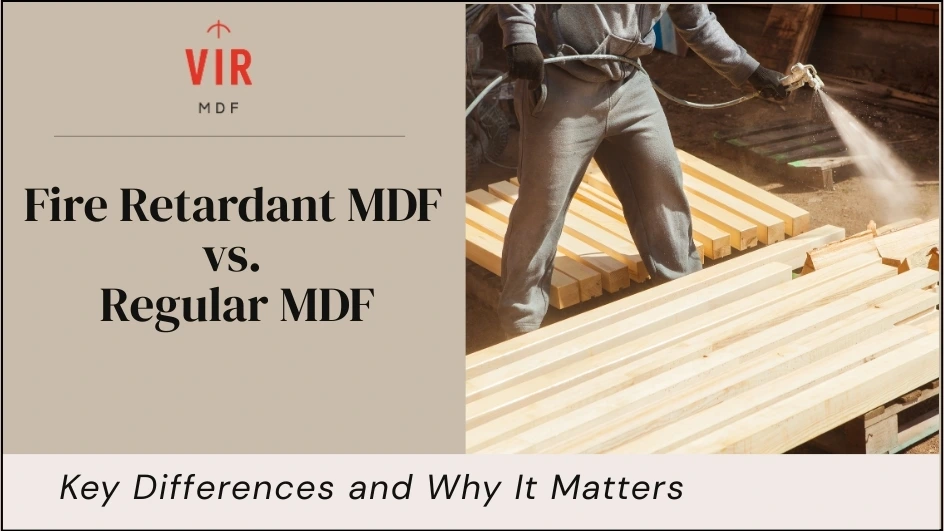Fire Retardant MDF vs. Regular MDF: Key Differences and Why It Matters
Posted on April 21, 2025
Medium-density fibreboard or MDF is a specially engineered wooden panel made from agro forestry wood. It is mixed with resins and treated under high temperature and pressure to make the panel boards. Fire retardant MDF is different from regular MDF in many ways. It is primarily created to resist fire, which is impossible for ordinary MDF. The standards set for fire retardant MDF in different countries are based on the quality of fireproof materials used in manufacturing this engineered wood.

Notable differences between fire retardant MDF and regular MDF
Fire retardant (FR) MDF is red, which is a primary difference in appearance from regular MDF. This bright colour helps identify MDF that is specially designed to be fire-resistant. The use of FR MDF is essential for building purposes in many places, in compliance with local civic codes. The following are the major differences between fire retardant MDF and regular MDF:
- Non-combustible – Fire retardant MDF is specially treated to make it resistant to fire. So this variety of MDF is not easily ignited even if it comes too close to a source of fire. On the other hand, regular MDF can easily catch fire when it comes into contact with certain chemicals or is exposed to too much flames.
- Chemical treatment – Fire retardant MDF is treated with either aluminium trihydrate or some phosphates. These additive chemicals can make it highly resistant to fire and usable in places that are sensitive to combustion. Regular MDF does not receive this special treatment, due to which it is not fire-resistant.
- Safe applications – Fire retardant MDF can be used in buildings housing corporate offices, commercial establishments and storage places. As a fire breakout can have severe effects in these buildings, all doors, windows, shelves and furniture pieces are preferably manufactured of FR MDF. So, the popularity of FR MDF is much more than regular MDF as an important building material.
- Better durability – The chemical treatment of FR MDF is believed to enhance its strength, making it more durable than regular MDF. The internal bonding of fire retardant MDF is much stronger than ordinary ones, for which it can last for many years. This physical property of FR MDF is beneficial for building purposes.
- Ensures better safety – Since FR MDF stops the spread of fire; it is preferred in hospitals, schools, colleges, hotels, commercial spaces and government offices. It also prevents the formation of toxic fumes, which is a prime hazard when regular MDF burns in fire.
Why is fire retardant MDF preferred over regular MDF?
The demand for fire retardant MDF as a building material is increasing rapidly worldwide. A few factors are directly responsible for its huge popularity in the construction industry.
Building codes – Governments of several countries have declared the use of fire-retardant MDF as one of the prime regulations to be maintained in every building construction. The countries of the Middle East are the foremost ones to start the application of FR MDF in different parts of buildings. Hence, the production and sale of this fibreboard have increased to a great extent in these places.
Vital safety measure – Accidental fire breakouts are a serious problem in urban areas, causing loss of lives and property. The rapid use of fire retardant MDF has reduced the number of such unfortunate incidents. Doors, windows, interior wall and ceiling panels, countertops and furniture made of FR MDF prevent the quick spread of fire from one room to another, saving people from severe disasters. Thus, the use of this fibreboard is considered a vital safety measure against fire.
Urban development – Fire retardant MDF is now widely used in hospitals, educational institutions and many other commercial establishments. Industrial manufacturing units are also now made of this fibreboard, to prevent the spread of accidental fire there. It is also used in making transportation infrastructure, like railway stations, airports and buses stations, wherever wooden structures are needed. Doors, partitions and countertops are preferably made of FR MDF in all these important buildings, to ensure the safety of thousands of people visiting these places daily.
The most common applications of fire retardant MDF
Fire retardant MDF is now commonly used in building the following structures, to ensure the safety of people from fire.
False ceilings and wall panels – Many residential and commercial buildings now have false ceilings for interior décor and also to keep rooms cooler, mainly on the top floors. These ceilings are preferably made of fire-retardant MDF to ensure safety in a fire breakout. These false ceilings and wall panels also increase the longevity of buildings.
Cabinets and countertops – All countertops and cabinets in kitchens are now preferred to be made of fire-retardant MDF. The kitchen is the most vulnerable space to fire breakout, as cooking is done here with the help of fire. FR MDF structures are expected to stop the spread of fire till people get time to run out to safety. Shelves and furniture items are also made of this fibreboard, rendering them safer in kitchens and other rooms as well.
Read More: Should I Use MDF for Cabinets?
Public transport – The doors and seats of all buses and trains are now made of fire retardant MDF, making these vehicles safer from accidental fires. Passengers can get time to flee in case a fire breaks out, as the fire is prevented from spreading rapidly.
Hospitals and laboratories – All the doors, windows, countertops and cabinets of hospitals, healthcare centres, educational institutions and laboratories are now made of FR MDF. So people should feel safe while visiting these places.
Conclusion
Though fire retardant MDF is not absolutely fireproof, it takes a quite long time to ignite compared to regular MDF. So, it is considered much safer and widely used for construction purposes for the safety of people.